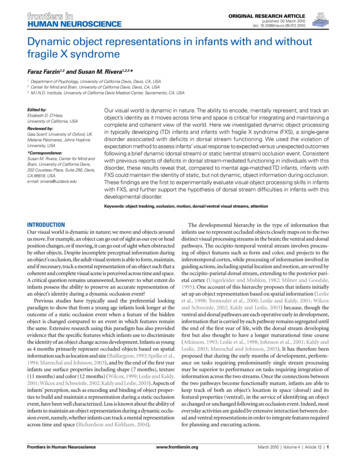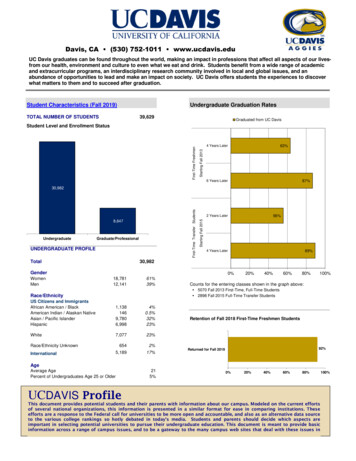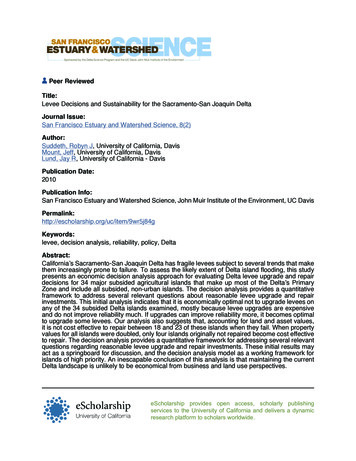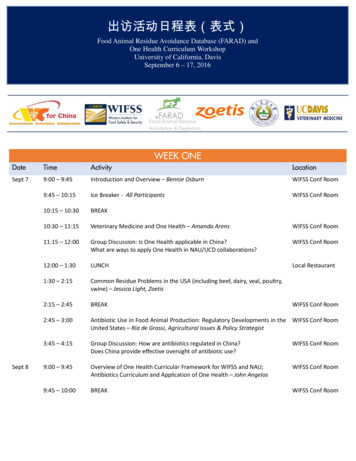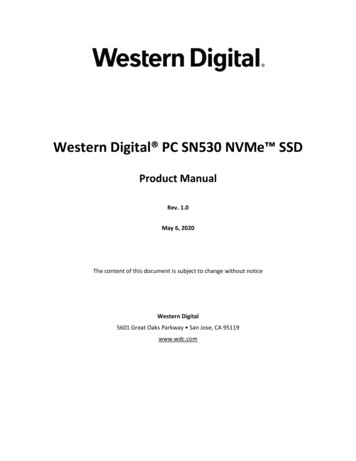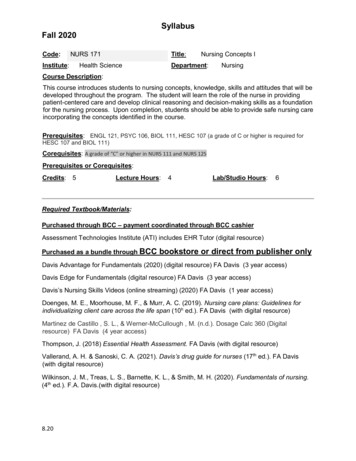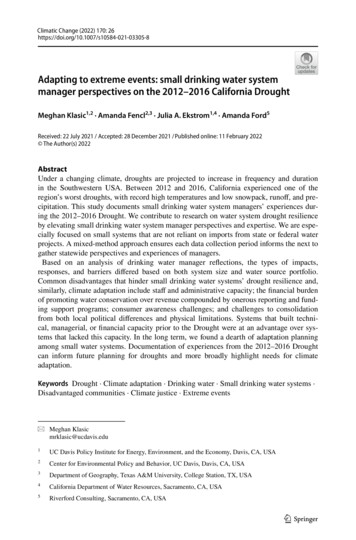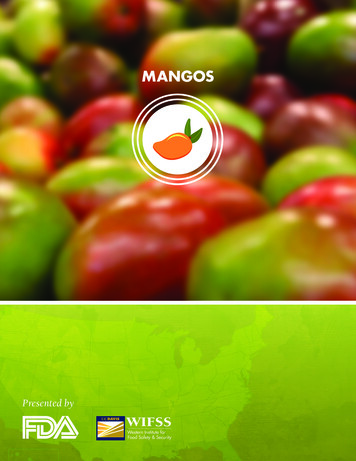
Transcription
MANGOSPresented by
MANGOSThis production summary provides an overview of mango growing, harvesting, and post harvesting practices. Thereare some common practices that many large commercial growers use when producing mangos, and though there arevariations in these practices, having an understanding of the most common methods used will be helpful when carryingout regulatory activities.By the end of this summary, you will be able to:1. List the top producing regions in the U.S. and world for mango production.2. Identify the most common farming practices used in the production of mangos including the use of equipmentand manual labor.The mango is a stone fruit which belongsto the Anacardiaceae family, which areINTRODUCTIONflowering plants that produce fruits.Mangos are native to south Asia and isthe national fruit of India, Pakistan, andthe Philippines. Since the mango leavesare considered toxic and can kill cattle or other grazinglivestock, mango growers and livestock owners need to bemindful about not locating grazing areas near mango grovesand not feed production discards to animals.Global production of mangos has doubled in the last thirtyyears. Most mango production is centered in India, China,Thailand, Pakistan, and Mexico, but there are currentlymore than 90 countries that grow mangos commercially.Countries in the Americas and Africa produce a smallpercentage of the world’s mango crop each year—13 percentand 10 percent, respectively. Asia, where the mango isnative, is the largest mango-producing region, producing 77percent of global supply annually. Within the U.S., a limitednumber of mangos are grown in Florida, Hawaii, California,and Puerto Rico (Fig 1). U.S. commercial production ofmangos began with the introduction of the Haden variety ofmango in 1863 in Miami.International mango trade is increasing, with exports soldto European and U.S. markets. Most of the mangos soldin the United States are imported from Peru, Ecuador,Brazil, Guatemala, Haiti, and Mexico. Eighty-six percentof the mangos imported into the U.S. are supplied byMexico, making this country the largest supplier to theUnited States.Mango trees are deep-rooted evergreens that can grow to bevery large. Depending on the variety, these trees can grow astall as 90 feet with a canopy width of up to 80 feet and haveleaves that are 12 to 16 inches long. Today the most popularcultivated mango varieties include: Tommy Atkins, Keitt,Kent, Osteen, Haden, and Valencia Pride.Mangos have two growing seasons - spring through summerand fall through winter. Due to the alternate harvest timesin the various growing regions around the world, the fruit isavailable year-round to U.S. consumers.Fig 1 - Top Mango Producing States in the USThe immature fruit has green skin that gradually turnsyellow, orange, purple, red, or combinations of thesecolors as the fruit matures. Mature fruit has a characteristicfragrance and a smooth, thin, tough skin. The paleyellow or orange flesh of ripe mangos is juicy, sweet, andsometimes fibrous.MANGOS 2
Mangos can be grown in a wide range ofsoil types, from light sandy loams to redGROWINGclay. Deep, rich, well-drained soils providethe best production and fruit quality. Someproducers plant trees on sloping sites toprevent waterlogging the root system. Mangos grow best inambient temperatures rangingbetween 70º to 75ºF.Commercial mangos are propagated vegetatively, meaningthe trees are reproduced via asexual reproduction by graftingonto rootstock.There are several main mango cultivars used in commercialproduction of the fruit. These cultivars are described aseither polyembryonic or monoembryonic. Polyembryonicvarieties can be grown from seed and produce trees that aretrue to type. Monoembryonic cultivars contain one embryothat has genes from both parents and produce a hybrid tree(mix of both parents), and therefore, must be reproducedvegetatively by grafting onto a root stock. Polyembryoniccultivars are often used as rootstock because they tend to bebetter adapted to local growing regions and soil conditions,and the grafted monoembryonic cultivars tend to producefruit with characteristics that are preferred by consumers.Grafted trees usually begin producing fruit in three to fiveyears, while trees planted from seeds usually take at leastfive years before bearing fruit. Mango trees can remain inproduction for 40 years or more.Mango trees require space to grow and are generally plantedin rows with 10 to 30 feet between individual trees and 20to 30 feet between rows. Developing trees are pruned sothat there are three to four main branches on the trunk atdifferent heights, and to remove any branches that are lessthan two feet from the ground. Mature trees are periodicallytrimmed to allow for better penetration of sunlight,spraying, and ease of picking.Mango trees are annually fertilized with nitrogen,phosphorus, and potassium. Newly planted trees should bewatered at planting and every other day for the first week,and then irrigated once or twice a week for the first coupleof months. Mature trees do not need frequent wateringbecause of the tropical climate in the regions where mangosare grown. Irrigation may be necessary during occasionaldry periods, but the roots can become water logged ifover irrigated.Insect and fungal diseases are controlled by pruningdiseased branches or spraying with insecticides orfungicides. Fruit flies can be a problem in certain growingregions and may limit distribution of the harvested fruit.For example, mangos produced in Hawaii are not permittedin the U.S. mainland, Japan, or other markets because ofquarantine restrictions due to fruit flies and mango seedweevil. Mangos from other regions are treated in a hot waterbath following harvest to eliminate pests and protect thefruit from decay.Mango trees begin blooming in the winter months andcontinue through spring. Most blossoms function as malesby providing pollen, but some are bisexual and are selfpollinating. Insects such as flies, wasps, and bees helpaccomplish pollination. Depending on the variety, the fruitmay take from 100 to 150 days to mature, resulting in a latesummer and fall harvest. The weight of the mature fruit mayvary from one-quarter pound to two pounds and may beround or oblong depending on the variety.MANGOS 3
ripening and shortens potential shelf life. On most farms,the fruit may wait from 30 minutes to 6 hours before theyare transported to the packinghouse.Mangos marketed in the United States areusually picked at the mature green stageHARVESTINGto withstand postharvest handlingpractices. Mangos are picked by hand orby using a long picking pole which has acanvas or nylon bag attached near a cutting blade to catchthe fruit. Ladders and hydraulic lifts are also used to helppickers reach fruit high in the tree canopy. Mango fruits areusually picked before they are fully ripe with the stem intactand after they develop red, orange, or yellow color. Thelong stem assures that the internal latex, or juice, does notleak. The fruit are stored stem end down on racks to furtherprevent latex from dripping on other fruit. The fruit bruiseseasily and must be handled carefully to avoid damage.Industry harvesting guidelinesrecommend that mangos be protectedPACKINGfrom exposure to direct sunlight whilethey wait transport to the packinghouse.Direct sunlight results in sunburn andhigher flesh temperatures, which in turn acceleratesMangos can either be offloaded to the packinghouse infield crates or from trucks with large cargo holds. Uponarrival at the packinghouse, mangos are transferred into awater flume system, where they are sprayed and brushedto remove soil, latex and other organic materials. Next, thefruit is pre-sized and placed back into crates. Then, in orderto control fruit flies, mangos are immersed in a hot waterdump tank for a time period that can range from 65 to 110minutes, depending on fruit variety, weight, and size. Thehot water tank is filled with potable water at 115ºF. Somepackinghouses will then conduct a post-water treatmentcooling, known as hydrocooling, after the hot watertreatment to rapidly decrease the flesh temperature andreduce injury to the fruit. Hydrocooler water temperaturesare usually maintained between 70º to 72ºF and the mangosare exposed to the cool water for about 30 minutes. Industryguidelines provide time and temperature recommendationsfor hydrocooler use with mangos to prevent water uptakeinto the harvested fruit.The fruit is transferred back to a packing line and graded byweight and size in accordance with USDA standards and/orbuyer requirements. Grading allows for removal of mangosthat are misshaped, bruised, cut, or have signs of decay. Somefruit may undergo a coating of wax to improve natural fruitgloss and reduce water loss during holding and transport.Mangos are packed into ventilated, single-layer cartons withor without lids. The openings in the cartons are importantto ensure uniform temperature and humidity during storageand shipping.MANGOS 4
HOLDINGPrior to shipping, mangos are held inforced air-cooling rooms where thetemperature is maintained at 54ºF.Mangos produced in other countries areoften picked at the mature-green stage in order to withstandthe postharvest handling steps required to export them fromthe production areas to the retail market. Upon arrival, thisfruit can be treated with ethylene gas in holding chambers inmuch the same way bananas are held in ripening rooms toinduce faster and more uniform ripening and provide readyto-eat mangos that consumers prefer.CONCLUSIONHaving a basic understanding of the way mangos are grown, harvested, and cooled will providethe basic background information that will be helpful to regulators when completing inspectionsor investigations in the ield.The agricultural practices described in this production summary are common on most large commercialfarms like those found in major mango producing regions, and in the United States. There are undoubtedlyvariations in these practices depending on the region, operation size and individual grower preferences.This is especially true of farms outside of the U.S.MANGOS 5
REFERENCES“Commodity Profile - Mango.” MANGO - An INFOCOMM Commodity Profile (n.d.): n. pag. UNCTAD, 26 Apr. 2012. Web. 13July 2016.Gilman, F. Edward and Dennis G. Watson. “Mangifera indica: Mango” University of Florida, IFAS Extension, Feb. 2013. Web. 12July 2016.Govindarajan, Reaganathan M. “Interesting Facts About Mangos.” About Mangos. N.p., 24 July 2008. Web. 13 July 2016.“Mango Fruit Facts Page Information.” Grown in California, n.d. Web. 13 July 2016.“Mango: Recommendations for Maintaining Postharvest Quality.” University of California Postharvest Technology Center – UCDavis. Feb. 2015. Web. 12 July 2016.“Mango Poisoning.” Right Diagnosis. Health Grades, n.d. Web. 13 July 2016“Mango Varieties.” Mango.org. University of Florida, IFAS Extension, n.d. Web. 13 July 2016.Mossler, A. Mark and Jonathan H. Crane. “Florida Crop/Pest Management Profile: Mango” University of Florida, IFAS Extension,Jul. 2013. Web. 09 June 2016.Simonne, Amy, Linda B. Bobroff, Anne Coper, Sandra Poirier, Mildred Murphy, Mary Jo Oswald, and Chris Procise. “South FloridaTropicals: Mango.” University of Florida, IFAS Extension, Aug. 2007. Web. 12 July 2016.ACKNOWLEDGMENTSSpecial thanks to the National Mango Board for images.Funding for this presentation was made possible, in part, by the Food and Drug Administration through Cooperative Agreement 1U54FD004327. Views expressed inthis presentation do not necessarily reflect the official policies of the Department of Health and Human Services; nor does any mention of trade names, commercialpractices, or organization imply endorsement by the United States Government.MANGOS 6
more than 90 countries that grow mangos commercially. Countries in the Americas and Africa produce a small percentage of the world's mango crop each year—13 percent . Fig 1 - Top Mango Producing States in the US . and 10 percent, respectively. Asia, where the mango is . native, is the largest mango-producing region, producing 77
